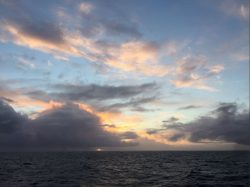
Clouds come in myriad shapes, sizes and types, which control their effects on climate. New research led by the University of Washington shows that splintering of frozen liquid droplets to form ice shards inside Southern Ocean clouds dramatically affects the clouds’ ability to reflect sunlight back to space.
The paper, published March 4 in the open-access journal AGU Advances, shows that including this ice-splintering process improves the ability of high-resolution global models to simulate clouds over the Southern Ocean – and thus the models’ ability to simulate Earth’s climate.
“Southern Ocean low clouds shouldn’t be treated as liquid clouds,” said lead author Rachel Atlas, a UW doctoral student in atmospheric sciences. “Ice formation in Southern Ocean low clouds has a substantial effect on the cloud properties and needs to be accounted for in global models.”
Results show that it’s important to include the process whereby icy particles collide with supercooled droplets of water causing them to freeze and then shatter, forming many more shards of ice. Doing so makes the clouds dimmer, or decreases their reflectance, allowing more sunlight to reach the ocean’s surface.
Read more at UW News »
